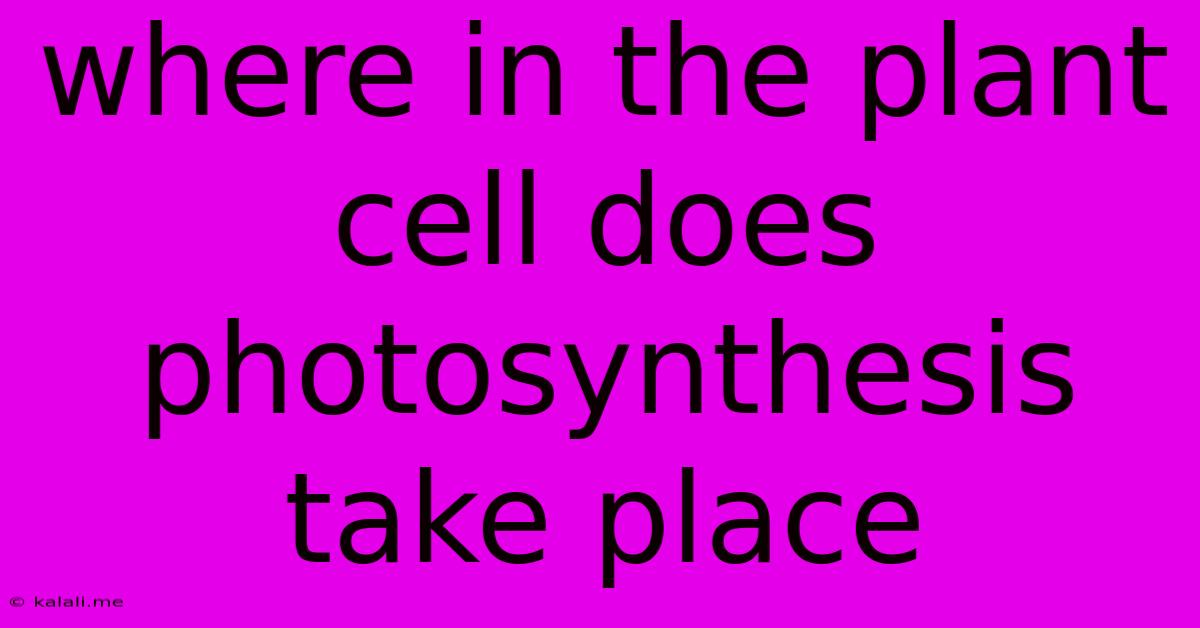Where In The Plant Cell Does Photosynthesis Take Place
Kalali
May 10, 2025 · 3 min read

Table of Contents
Where in the Plant Cell Does Photosynthesis Take Place? A Deep Dive into Chloroplasts
Photosynthesis, the remarkable process by which plants convert light energy into chemical energy, is a cornerstone of life on Earth. But where exactly within the plant cell does this vital process unfold? The answer lies within specialized organelles called chloroplasts. This article will delve into the structure and function of chloroplasts, exploring their crucial role in photosynthesis and highlighting the specific locations within these organelles where the light-dependent and light-independent reactions occur.
Understanding the Chloroplast: The Photosynthesis Powerhouse
Chloroplasts are double-membraned organelles found in the cells of plants and algae. They are often described as the "kitchens" of the plant cell, as they are the sites of photosynthesis, the process that produces the plant's food (glucose) and oxygen. Their unique structure is perfectly adapted to facilitate this complex process. This includes:
- The Outer Membrane: A selectively permeable barrier controlling the entry and exit of substances.
- The Intermembrane Space: The narrow region between the outer and inner membranes.
- The Inner Membrane: Another selectively permeable membrane that encloses the stroma.
- The Stroma: A fluid-filled space containing enzymes, DNA, ribosomes, and thylakoids. This is where the light-independent reactions (also known as the Calvin cycle) take place.
- Thylakoids: A system of interconnected, flattened membrane sacs within the stroma. These are stacked into structures called grana. The light-dependent reactions of photosynthesis occur within the thylakoid membranes.
- Grana: Stacks of thylakoids that maximize surface area for light absorption.
- Thylakoid Lumen: The space inside a thylakoid. This plays a crucial role in the light-dependent reactions, particularly in the establishment of a proton gradient.
The Two Stages of Photosynthesis and Their Location within the Chloroplast
Photosynthesis is a two-stage process:
1. The Light-Dependent Reactions: Harnessing Solar Energy
This stage occurs within the thylakoid membranes. Here, chlorophyll and other pigment molecules capture light energy. This energy is then used to split water molecules (photolysis), releasing oxygen as a byproduct. The energy is also used to generate ATP (adenosine triphosphate) and NADPH (nicotinamide adenine dinucleotide phosphate), which are energy-carrying molecules crucial for the next stage. The precise location within the thylakoid membrane involves specific protein complexes embedded within the membrane itself, facilitating electron transport and ATP synthesis. The thylakoid lumen plays a crucial role in establishing the proton gradient driving ATP synthesis.
2. The Light-Independent Reactions (Calvin Cycle): Building Sugar
The light-independent reactions take place in the stroma. Here, the ATP and NADPH generated during the light-dependent reactions are utilized to convert carbon dioxide (CO2) into glucose, a simple sugar. This process is a cyclical series of chemical reactions, also known as the Calvin cycle, that effectively "fixes" carbon from the atmosphere into organic molecules. The enzymes responsible for catalyzing these reactions are located within the stroma.
Conclusion: A Coordinated Cellular Symphony
In summary, photosynthesis is a finely tuned process occurring within the chloroplasts of plant cells. The light-dependent reactions happen within the thylakoid membranes, while the light-independent reactions occur in the stroma. The intricate structure of the chloroplast, with its distinct compartments and specialized proteins, allows for the efficient capture and conversion of light energy into the chemical energy stored in glucose—a fundamental process supporting virtually all life on Earth. Understanding the precise location of these reactions within the chloroplast is key to appreciating the complexity and efficiency of this vital process.
Latest Posts
Latest Posts
-
Jaguar Adaptations In The Tropical Rainforest
May 10, 2025
-
How To Find Average Velocity From Velocity Time Graph
May 10, 2025
-
What Is Non Living Things In The Ecosystem
May 10, 2025
-
How Many Fl Oz In 6 Cups
May 10, 2025
-
What Is 1 Percent Of 5000
May 10, 2025
Related Post
Thank you for visiting our website which covers about Where In The Plant Cell Does Photosynthesis Take Place . We hope the information provided has been useful to you. Feel free to contact us if you have any questions or need further assistance. See you next time and don't miss to bookmark.